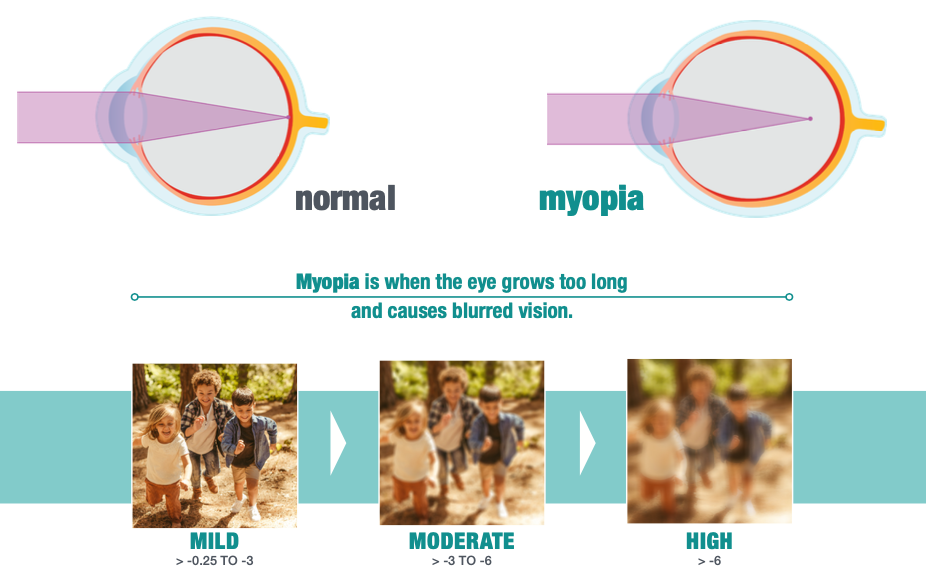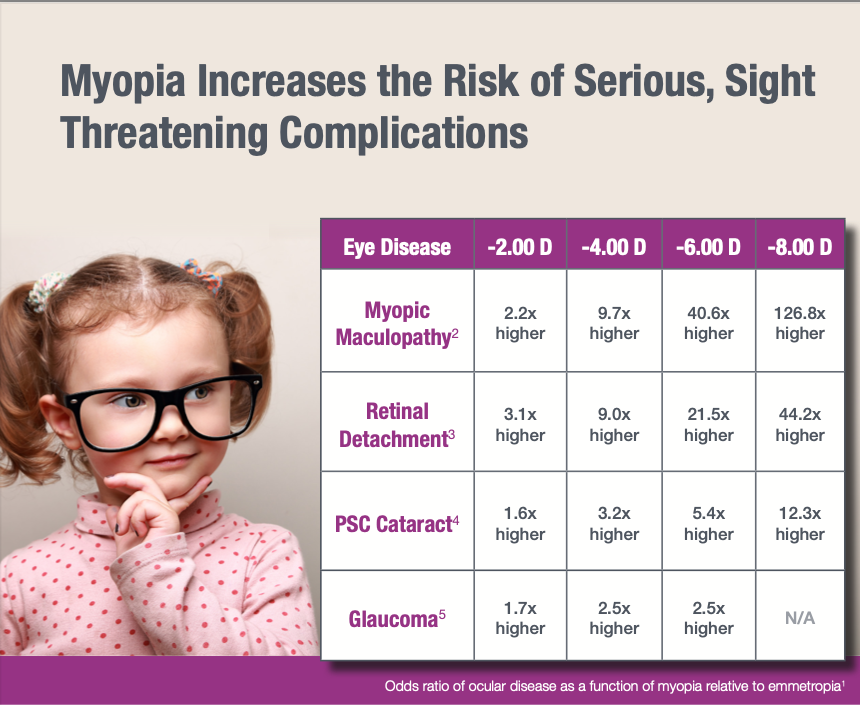Myopia, or nearsightedness, occurs when the length of the eye is “too long” or the corneal power is “too strong”. This causes light to focus in front of the retina instead of on the retina causing a blurred image.
What is myopia?

Prevalence of Myopia:
Myopia is on the rise. One in four parents have a child with myopia, which equals to about 14 million kids in the United States. The prevalence of myopia in kids has nearly doubled since the 1990s, and nearly 50% of kids are expected to by myopic by 2050.
Why do we care about myopia in kids?
Besides the obvious immediate problem myopia can cause, blurred vision, there can be long term effects to the health of the eyes.
What long term ocular health risks does myopia pose?
Patients that are myopic are at a higher risk for cataracts, glaucoma, retinal detachment and myopic maculopathy. The highest risk of permanent vision loss comes from myopic maculopathy.

Benefits of keeping myopia “low”:
⦁ Better candidate for refractive surgeries in the future (i.e. LASIK)
⦁ Lower cost in contact lenses and glasses (avoiding specialty contact lenses and more expensive lenses in glasses)
⦁ Better long term vision and ocular health

How can I tell if my child has myopia?
⦁ Because kids do not always know what that should or should not be able to see, myopic changes in vision can be very subtle. Some signs you might observe at home are frequent headaches, squints to read, standing too close to TV, eye rubbing, worsening school or athletic performances. The best way to know for sure is a comprehensive eye examination.
How does Wildwood Vision diagnose Myopia?
⦁ At your child’s comprehensive eye examination, a visual acuity will be performed to get a measurement of your child’s functional vision.
⦁ The doctor will use an instrument designed to measure the curvature of the corneal and lens of the eyes to give an approximation in the amount of refractive error. The doctor may also use a retinoscope to check the reflex from the front surface of the eye to determine if there is any refractive error. Finally, a refraction will be performed to come up with the final prescription for your child.
⦁ Wildwood Vision Specialist, in addition to a full detail picture and scan of the back of the retina, now has the ability to measure axial length. The axial length of the eye provides Drs. Brown and Hayes crucial information to be able to predict the risk factor for developing myopia.

How does Wildwood Vision Specialists treat myopia in children?
⦁ Traditional glasses and contact lenses can help children see more clearly but do NOT slow the progression of myopia.
⦁ The options below have been shown to slow the progression of myopia.

What can I do today?
⦁ Click ⦁ here to schedule your child’s annual comprehensive eye examination. Your doctor will determine your child’s current refractive error and assign a risk zone for developing myopia.
⦁ If your child is at risk or has myopia, your doctors at Wildwood Vision Specialists will discuss a unique myopia management plan for your child.
⦁ If your child does not have myopia, or is in a low-risk category, there are a few strategies to keep the risk of developing myopia low.
⦁ Increase outdoor time: Sunlight helps to promote healthy eye grown and lowers the changes of nearsightedness in children
⦁ Limit screen time: Practice the 20-20-20 rule. Take frequent breaks from digital devices and near work; take a 20 second break every 20 minutes and look at something 20 feet away. This helps reduce eye strain and fatigue.
